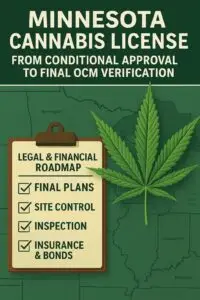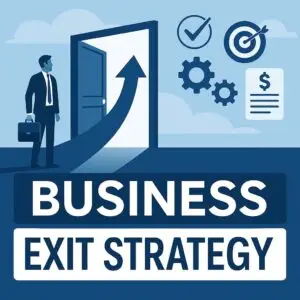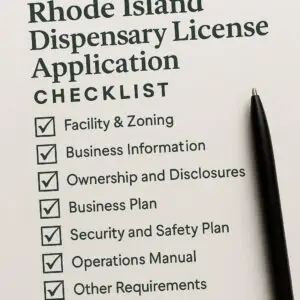You Cleared the Lottery…Now the Heavy Lifting Starts
 Congratulations—your application just earned preliminary approval from the Minnesota Office of Cannabis Management (OCM). Enjoy the win, then buckle up. You also got notice of the Final OCM Verification that can only be only to be completed after you receive notification from the Office of Cannabis Management (OCM) that you’ve advanced to preliminarily approved status. You conditional notice isn’t a permission slip to open; it’s a binding agreement that you will prove every promise you made in your original filing, on time and in full.
Congratulations—your application just earned preliminary approval from the Minnesota Office of Cannabis Management (OCM). Enjoy the win, then buckle up. You also got notice of the Final OCM Verification that can only be only to be completed after you receive notification from the Office of Cannabis Management (OCM) that you’ve advanced to preliminarily approved status. You conditional notice isn’t a permission slip to open; it’s a binding agreement that you will prove every promise you made in your original filing, on time and in full.
The next phase is the Verified License Application, anchored by the OCM’s Final Plans of Record. In the months ahead you must:
-
upload fully executed SOPs to Accela,
-
lock down a compliant property,
-
secure local zoning and building permits,
-
pass a pre-licensure inspection, and
-
pay the initial license fee—
all within 18 months of the notice date. Miss a single requirement and the State will skip your spot and pull an alternate applicant.
This guide maps those legal mandates to the financial realities—bonds, build-out capital, insurance, and cash-flow timing—so you can turn conditional status into a revenue-generating license.
1. Conditional Approval ≠ Carte Blanche
A conditional license is effectively a performance contract. The OCM expects you to:
-
Register your site in Accela—even if the address appeared in your application.
-
File the Final Plans of Record (PDFs under 10 MB uploaded to Accela; larger files via the “Site Information” step). mn.gov
-
Obtain local government sign-offs: zoning confirmation, building permits, fire-marshal clearance, and—if you’re retailing—municipal operating registration.
-
Pass the OCM pre-licensure inspection that cross-checks every SOP against facility reality.
Failure to hit any deadline risks forfeiting your slot.
2. Final Plans of Record—From Drafts to Compliance Armor
The OCM accordion menu lists four universal forms every licensee must submit: mn.gov
| Required Plan | Purpose | Key Details to Nail |
|---|---|---|
| Site, Security & Operations Plan | Show physical security and workflow | Camera grid (24-hour, 720 p minimum), alarm spec, restricted-area controls |
| Inventory Control & Diversion-Prevention SOP | Demonstrate seed-to-sale integrity | METRC workflow, daily reconciliations, discrepancy reporting |
| Quality Assurance SOP | Ensure product safety & testing cadence | Batch sampling, COA management, recall triggers |
| Accounting & Tax Compliance SOP | Prove fiscal transparency | Chart of accounts, excise-tax remittance, audit trail retention |
License-Specific Add-Ons
-
Vehicle Disclosure Form – any licensee moving cannabis must list make/model, VIN, GPS, lockbox specs, plus $300 k cargo / $1 M liability bond minimums.
-
Industrial-Hygiene Certifications – required for volatile-solvent extraction rooms.
-
ISO-17025 Accreditation Plan – mandatory for testing laboratories.
Tip: Cross-reference each SOP section to NFPA, OSHA, or Minnesota Rule drafts so reviewers spend less time asking follow-up questions.
3. Site Control, Build-Out & Local Politics—Where Deals Die
Lease, Deed & Lender Riders
Your real-estate instrument must explicitly permit cannabis operations and grant OCM inspectors access. Secure lender consent—banks dislike surprise Schedule I tenants.
Permitting Gauntlet
-
Building permits for walls, vaults, HVAC, fire sprinklers.
-
Fire-marshal approval—egress, emergency power, haz-mat storage.
-
Municipal operating permit (where ordinances require one). Public hearings are common; arrive with data on jobs, tax revenue, and odor control.
Capital Clock
Average timelines and cash burn:
| Stage | Weeks | % of CapEx |
|---|---|---|
| Architectural & permitting | 6-10 | 5 % |
| Construction & MEP | 16-24 | 70 % |
| Equipment commissioning | 4-6 | 20 % |
| Contingency | — | 10 % |
Front-load liquidity; a single two-week lag on HVAC can push opening day a quarter and shred IRR.
4. Capitalization, Bonds & Insurance—Show Me the Money
OCM can demand an updated capitalization table with any ownership change—and will not schedule inspection until the financial picture is spotless. mn.gov
| Milestone | Payee | Typical Amount |
|---|---|---|
| Inspection bond | Surety carrier | $25 k–$50 k |
| Cargo & Auto liability bond | Carrier | $300 k / $1 M |
| Initial license fee* | OCM | $2.5 k – $30 k |
| Builders’ risk & GL insurance | Carrier | 0.5–1 % of project value |
*Fee varies by license class; see OCM fee schedule.
Funding stack tactics
-
Bridge SAFE → Series A: Release equity on “inspection passed” milestone.
-
PACE/C-PACE financing: Offload HVAC and solar to 20-year tax assessments.
-
Equipment leasing: Conserve cash for working capital.
Aim for cash or committed credit equal to 14 months operating expense—OCM’s 18-month deadline leaves little room for revenue delays.
5. Pre-Licensure Inspection—Dress Rehearsal With Real Consequences
OCM inspectors will cross-walk every SOP paragraph against real-world implementation:
-
Mock audit: Run an internal walk-through with legal & ops and generate a punch-list.
-
Document war-room: Digital and hard copies of every plan, permit, bond, insurance certificate, and training log at arm’s reach.
-
Staff drills: Budtenders recite ID-check protocol; cultivators demonstrate METRC tag scanning; security pulls live camera footage.
-
Variance binder: Any deviation from filed plans (e.g., extra camera) needs a stamped addendum.
Inspection deficiencies trigger a Corrective Action Letter with a firm clock—fix fast; the 18-month deadline keeps ticking.
6. Social-Equity Commitments—Deliver or Lose the License
If your preliminary score benefited from social-equity ownership or community promises, OCM will verify:
-
Operating agreements & voting rights—65 % ownership and control cannot be illusory.
-
Capital contributions—follow the money; side-option deals that claw back equity will fail.
-
Community impact KPIs—documented hiring, vendor diversity, and mentorship spend.
Create a quarterly social-equity dashboard (payroll + A/P exports) so you’re audit-ready. Bluffing invites denial—or worse, post-launch revocation.
7. Insurance, Bonding & Final Paper Cuts
Before OCM emails your physical license PDF, you must present:
-
General & product liability—$1 M per occurrence / $2 M aggregate.
-
Property/crop insurance—cultivation only.
-
Workers’ compensation—no waivers.
-
Cargo & auto liability—if you move product.
-
Surety bonds—inspection, tax, or cargo, as applicable.
Start shopping carriers early; underwriters still view cannabis as higher risk, and quoting cycles can stretch 30 days.
8. Timeline Snapshot—The 18-Month Race
OCM gives preliminarily approved applicants 18 months to complete site registration, file final plans, pass inspection, and pay the license fee.
| Scenario | Build-Out Finish | Revenue Start |
|---|---|---|
| Optimistic | 8 months | Month 9 |
| Baseline | 12 months | Month 13 |
| Pessimistic | 18 months | Month 19 |
Plan burn-rate accordingly and keep lenders in the loop—nothing scares capital like silent schedule slip.
Conclusion – Finish Strong, Launch Confident
Minnesota’s cannabis market rewards finishers, not sprinters. Conditional approval got you through the first gate; now regulators, municipalities, and investors demand flawless execution: stamped floor plans, bullet-proof SOPs, lined-up insurance, and cash to survive a year of zero revenue.
Collateral Base lives in this gap between theory and launch. We stress-test pro-formas, structure bond packages, negotiate landlord riders, and assemble inspection-proof data rooms—all while keeping your cap table investor-friendly and your social-equity promises iron-clad.
Ready to transform that OCM letter into a thriving business? Schedule a strategy call today and cross the finish line with confidence.
Disclaimer: This article is for informational purposes only and is not legal advice. Cannabis regulations change; consult qualified counsel for guidance tailored to your circumstances.





